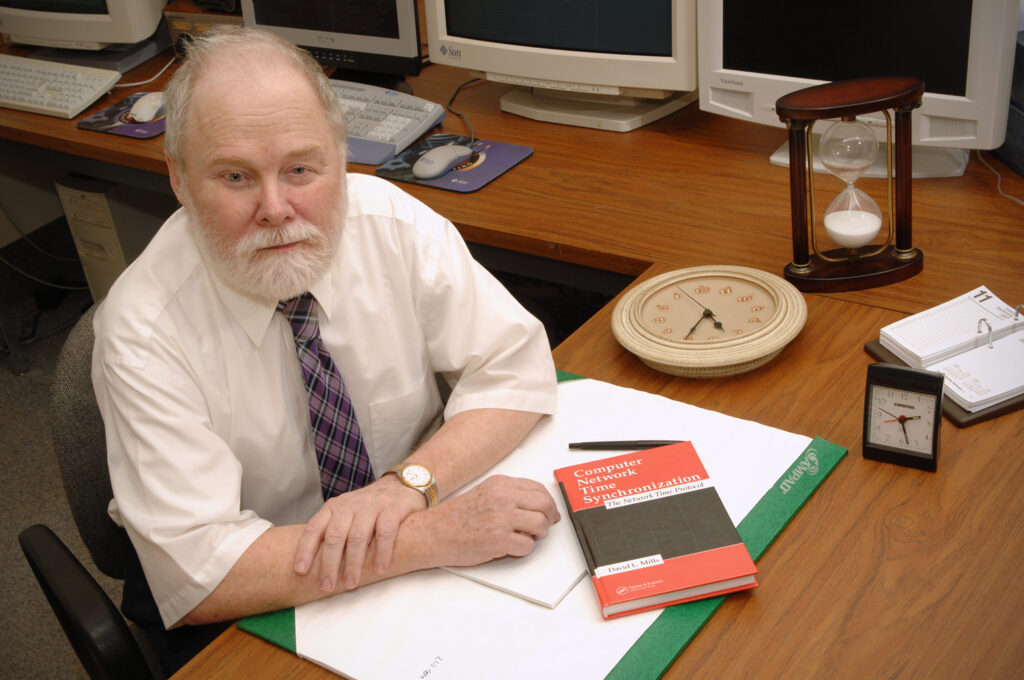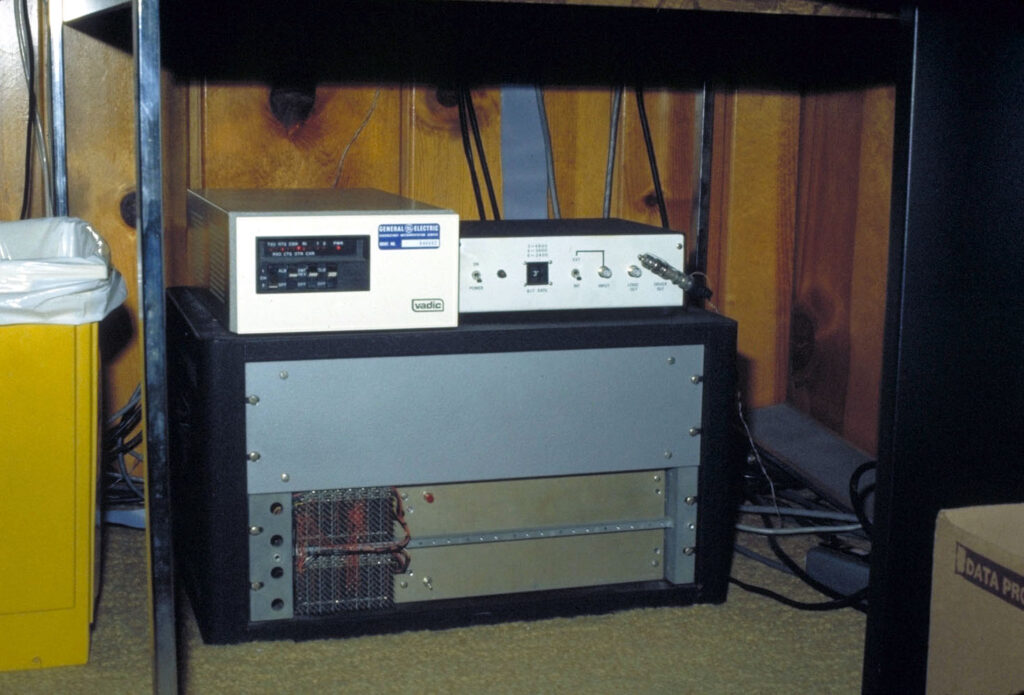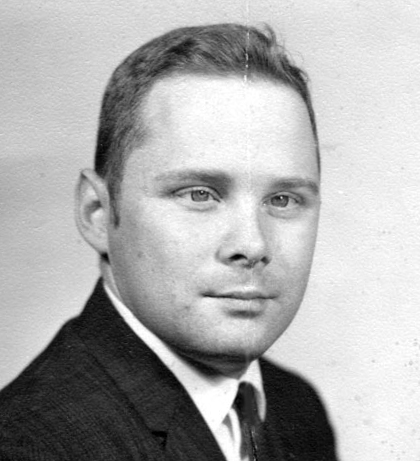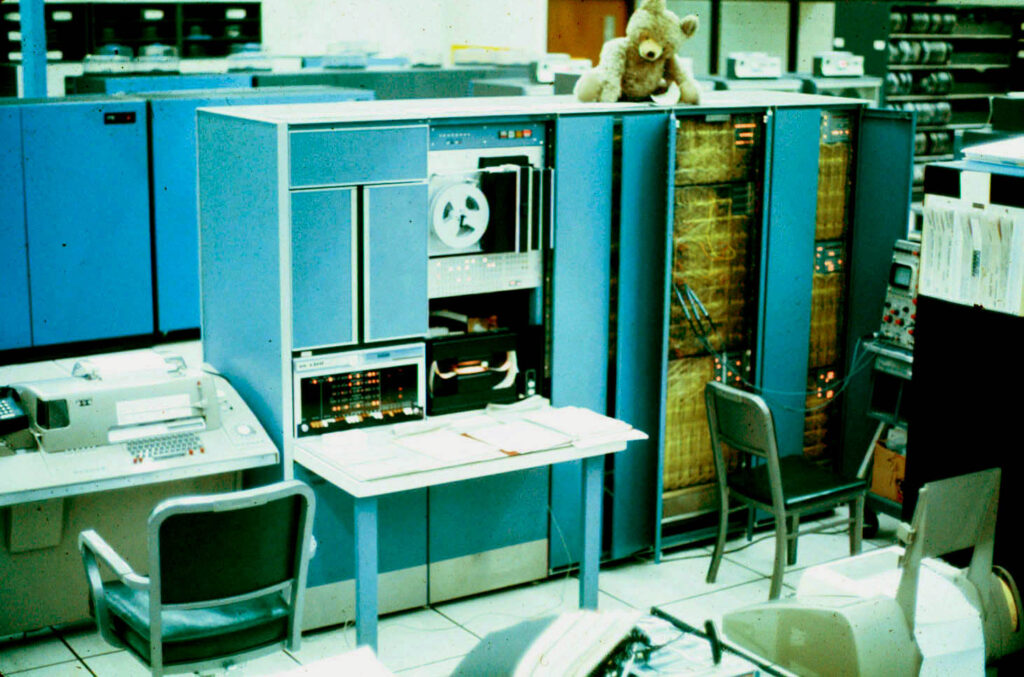Remembering alum David Mills, who brought the internet into perfect time

Internet pioneer and Michigan alum David L. Mills (BSE SE 1961, BSE Math 1961, MSE EE 1962, MS CS 1964, PhD CCS 1971), the internet’s “Father Time,” passed away on January 17, 2024. He was 85. Despite a challenge with vision impairment due to a childhood onset of glaucoma, Mills made numerous significant contributions to the development of the internet over his career, including the design of the Network Time Protocol (NTP) which provides for precise clock synchronization between computers connected to the internet.
Mills had a lifelong interest in clocks, time, tinkering, and iterating, as well as an interest in ham radio. Perhaps for this reason, he noticed early that time synchronization would become critical to sharing information on networks.
“Dave had a love, perhaps even an obsession, with timekeeping,” said Charles Boncelet, Professor of Electrical & Computer Engineering and Computer & Information Sciences at the University of Delaware and a collaborator with Mills. “He was a fan of unusual clocks and calendars, such as the Mayan calendar. His laboratory had an atomic clock. He also had various radio clocks.
“He took a problem that few realized was a problem, synchronizing clocks, and made it his life’s work,” Boncelet continued. “Others took up the problem of time synchronization, but Dave was far ahead of them. Dave’s actual experience deploying NTP worldwide showed him the numerous practical problems that arise in the real world, as opposed to sanitary academic laboratories.”
“NTP was created to solve a fundamental limitation of computer clocks: over time they drift farther and farther apart from the actual time,” said Manos Kapritsos, Associate Professor of Electrical Engineering and Computer Science at the University of Michigan. “NTP addresses this shortcoming by continuously synchronizing computer clocks to some very accurate reference clocks, like atomic clocks. Of course, it would be impractical to have all clocks on the planet synchronize directly with an atomic clock. NTP therefore introduced a hierarchical structure (with the reference clocks at the top) where every machine could synchronize its clocks with multiple other machines in its vicinity. It then uses an intersection algorithm to combine these measurements into a single measurement.
“NTP is one of the oldest protocols currently running on the internet,” continued Kapritsos. “It owes its longevity to the robustness and redundancy in its design. Every machine doesn’t simply trust its neighbors or parents on the hierarchy to be correct; it synchronizes with multiple machines and only accepts a time reading as accurate if it is vouched for by multiple such interactions.
“If you want to appreciate the value of NTP in your daily life, simply compare the accuracy of the clock on your phone to that of a wall clock that is not connected to the internet (and thus cannot be running NTP). Your phone is likely within a few milliseconds of every other internet-connected device you own, while the wall clock is probably multiple minutes off.”

In addition to inventing NTP, while at the University of Maryland in the 1970s, Mills invented “The Fuzzball,” the first modern router and application server on the internet. Fuzzballs were DEC PDP-11 computers loaded with Mills’ software. Six fuzzball routers were later used in 1986 to build the first 56 kb/sec NSFNET backbone, a precursor to today’s internet, and this deployment allowed for the development of the first TCP/IP protocols. This version of the internet was superseded in 1988 when NSF contracted with MERIT, MCI, IBM, and the State of Michigan to build a 1.5 Mb/sec NSFNET which expanded to include additional nodes and higher speeds.
Mills was also known for his playful humor. In a 1988 article he authored for the ACM SIGCOMM Computer Communication Review, he joked that the Fuzzball “was designed, implemented and evolved over a seventeen-year era spanning the development of the ARPANET and TCP/IP protocol suites and can today be found at Internet outposts from Hawaii to Italy standing watch for adventurous applications and enduring experiments.”
Mills was the first chair of the Internet Engineering Task Force, a standards organization for establishing internet standards; was a lifelong contributor to open-source software; and made many other significant contributions to the development of packet-switched networks and the internet. He was recognized in 2013 with the IEEE Internet Award “for significant leadership and sustained contributions in the research, development, standardization, and deployment of quality time synchronization capabilities for the Internet.”
As a student at Michigan, Mills was hungry for knowledge about electronics and computing, and completed bachelor’s degrees in Engineering Science and Mathematics, master’s degrees in Electrical Engineering and Communication Sciences, and a PhD in Computer and Communications Science.

While an undergraduate, he worked part-time jobs to help pay tuition, in particular as an announcer, disk jockey, recording engineer, and FCC-licensed transmitter engineer for radio and television stations in Ann Arbor and Detroit. He was also a research assistant in the Electrical Engineering department, where he worked on sponsored projects involving radio direction finding, secure-speech transmission, frequency synthesis, and digital communication. He designed and supervised construction of an advanced analog/digital HF radio direction finder for the US Army.
“I first met Dave in the context of radio station involvement,” said Scott Gerstenberger, a member of the technical staff at the University of Michigan’s Computing Center and later an Associate Director. “I was involved in making the only known audio recording of John F. Kennedy’s remarks at the entrance to the Michigan Union in 1960 while he was running for president, when he first mentioned the idea of the Peace Corps. That recording was made using a small FM band transmitter sitting on the top of a step ladder near the Union entrance and transmitting to WCBN’s FM receiver around the corner in South Quad, where it was recorded in the control room. The FM transmitter was designed and made from individual components by Dave Mills and occasionally used for similar purposes by WCBN. It was built in an approximately 8” x 8” x 4” aluminum utility box that had a whip antenna and was probably only marginally legal.”
During his graduate studies, Mills performed early research into distributed computing and worked on the ARPA-sponsored Conversational Use of Computers (CONCOMP) project, which developed hardware and software for a DEC PDP-8 that allowed terminals such as Teletypes to connect over phone lines to an IBM 360/67 mainframe.
Mike Alexander, a member of the research staff of the Computing Center and Information Technology Division Research Systems from 1965 to 1996, worked with Mills from 1965 until 1971 and remembers him well.
“In 1966 I was laying the foundation for what would become the MTS (Michigan Terminal System) and Dave was designing and building the Data Concentrator to connect the outside world to it,” recalls Alexander. “The Data Concentrator was almost certainly the first non-IBM device to be connected to an IBM channel, and we spent many hours together debugging the interface. Dave was very low vision even then. It’s amazing he did as much as he did without today’s modern low vision aids. We used to joke that he would wire his nose into the back panel of the concentrator since he got so close to see the pins.
“He was one of the most interesting and smartest people I have ever known. He will be missed by all who knew him.”

Mills’ work on NTP gained momentum in the 1970s, and the protocol was first implemented in 1985 and tested on the Fuzzball-driven NSFNET. By 1988, he had refined NTP to the point where it could synchronize the clocks of connected computers that had been telling significantly differing times to within tens of milliseconds, and later to within a few microseconds. In October of 1991, Mills published Internet Time Synchronization: The Network Time Protocol in the IEEE Transactions on Communications, which described the protocol and how its architecture and algorithms maintained distributed timekeeping, even in cases of failures and disruption. He followed that up with Network Time Synchronization: the Network Time Protocol on Earth and in Space, a 2011 textbook that describes the principles of time synchronization, how NTP works, and the development of the protocol over time.
The current version of NTP, version 4, was released in 2010 and continues to keep time for all manner of internet-connected devices, from IoT devices through mobile devices; connected appliances, automobiles, and other devices; as well as desktop computers and data centers.
Mills’ work on time synchronization had specialized applications as well. “I lost track of Dave after he got his PhD and left U-M,” said Jack DiGiuseppe, who worked with Mills from 1965 to 1971 while a Research Assistant at the Computing Center. “Then, in 2004, I was working as a consultant for Blue Cross Blue Shield Association (BCBSA) on a network time synchronization project. Since Dave Mills was the foremost expert, we decided to hire him to consult on the project. He developed and presented recommendations for how to implement NTP on BluesNet, the BCBSA nationwide network used by all of the BlueCross and BlueShield health insurance plans. Time synchronization is critical to core applications on BlueNet.”
“Distributed applications rely on clocks to coordinate their actions in lots of ways, like placing time limits on security credentials or deciding how long to cache web pages,” said Peter Honeyman, Research Professor Emeritus in Electrical Engineering and Computer Science at the University of Michigan, when asked about the significance of NTP. “Prior to the invention of NTP, clock synchronization was ad hoc, clock disagreement between systems was rampant, and impossible things could happen, like time going backwards. NTP solves all of that, and with the advent of the always-connected, internet-everywhere world, NTP arrived at the very moment when it was most needed.”
Mills’ students also remember his influence well. “I first met Dave as a senior Computer Science student at the University of Maryland,” says Peter Allen, who is now an independent management consultant. “Having taken several introductory courses in operations research, graph theory, and basics of computer communications, my advisor suggested that I take Dave’s evening course on advanced networking concepts.
“Dave was unlike any professor I had ever encountered. He traveled from Delaware for these courses (not an easy transit given his vision challenges) and came prepared with enthusiasm and energy that epitomized genuine passion for the potential of autonomous operation of computing units. His use of colloquialisms and anecdotes conveyed the immense potential that he envisioned. He challenged his students to think differently and to imagine a world order that broke virtually every commonly accepted constraint.”
Mills remained an amateur radio operator and maintained a radio station at his home until the time of his death. On his university website, he called out the large rooftop antenna on his home and said that, “in emergencies, the rooftop antenna can be converted into helicopter rotor blades and lift the house to safety.”
After completing his PhD study at Michigan, Mills worked at the University of Maryland (1972-77), COMSAT Corporation (1977-82), and Linkabit Corporation (1982-1986) before joining the faculty of the University of Delaware as a Professor of Electrical & Computer Engineering and of Computer & Information Sciences in 1986. He became an emeritus faculty at Delaware in 2008. Mills was a member of the National Academy of Engineering and was a Fellow of both the Association for Computing Machinery and the IEEE.
Prof. David L. Mills is survived by his wife Beverly Mills, his daughter Eileen Schnitzler, his son Keith Mills, and his brother Gregory Mills.